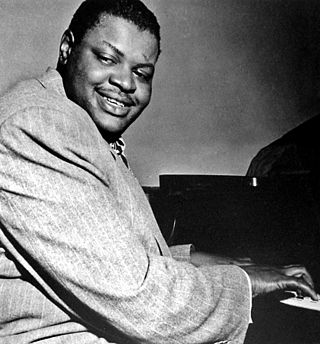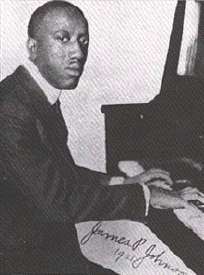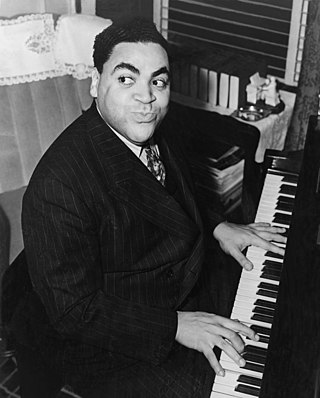Related Research Articles

Oscar Emmanuel Peterson was a Canadian virtuoso jazz pianist and composer. Considered one of the greatest jazz pianists of all time, Peterson released more than 200 recordings, won eight Grammy Awards, as well as a lifetime achievement award from the Recording Academy, and received numerous other awards and honours. He played thousands of concerts worldwide in a career lasting more than 60 years. He was called the "Maharaja of the keyboard" by Duke Ellington, simply "O.P." by his friends, and informally in the jazz community as "the King of inside swing".
Ragtime, also spelled rag-time or rag time, is a music genre that had its peak from the 1890s to 1910s. Its cardinal trait is its syncopated or "ragged" rhythm. Ragtime was popularized during the early 20th century by composers such as Scott Joplin, James Scott and Joseph Lamb. Ragtime pieces are typically composed for and performed on piano, though the genre has been adapted for a variety of instruments and styles. "Maple Leaf Rag", "The Entertainer", "Fig Leaf Rag", "Frog Legs Rag", and "Sensation Rag" are among the most popular songs of the genre.

Edward Kennedy "Duke" Ellington was an American jazz pianist, composer, and leader of his eponymous jazz orchestra from 1923 through the rest of his life.

Cecil Percival Taylor was an American pianist and poet.

James Price Johnson was an American pianist and composer. A pioneer of stride piano, he was one of the most important pianists in the early era of recording, and like Jelly Roll Morton, one of the key figures in the evolution of ragtime into what was eventually called jazz. Johnson was a major influence on Count Basie, Duke Ellington, Art Tatum, and Fats Waller, who was his student.

Stride jazz piano, often shortened to stride, is a jazz piano style that arose from ragtime players. Prominent stride pianists include James P. Johnson, Willie "the Lion" Smith, Fats Waller, Luckey Roberts, Mrs Mills and Mary Lou Williams.

Mary Lou Williams was an American jazz pianist, arranger, and composer. She wrote hundreds of compositions and arrangements and recorded more than one hundred records. Williams wrote and arranged for Duke Ellington and Benny Goodman, and she was friend, mentor, and teacher to Thelonious Monk, Charlie Parker, Miles Davis, Tadd Dameron, Bud Powell, and Dizzy Gillespie.

Louis Moreau Gottschalk was an American composer and pianist, best known as a virtuoso performer of his own romantic piano works. He spent most of his working career outside the United States.
The swing era was the period (1933–1947) when big band swing music was the most popular music in the United States. Though this was its most popular period, the music had actually been around since the late 1920s and early 1930s, being played by black bands led by such artists as Duke Ellington, Jimmie Lunceford, Bennie Moten, Cab Calloway, Earl Hines, and Fletcher Henderson, and white bands from the 1920s led by the likes of Jean Goldkette, Russ Morgan and Isham Jones. An early milestone in the era was from "the King of Swing" Benny Goodman's performance at the Palomar Ballroom in Los Angeles on August 21, 1935, bringing the music to the rest of the country. The 1930s also became the era of other great soloists: the tenor saxophonists Coleman Hawkins, Ben Webster and Lester Young; the alto saxophonists Benny Carter and Johnny Hodges; the drummers Chick Webb, Gene Krupa, Jo Jones and Sid Catlett; the pianists Fats Waller and Teddy Wilson; the trumpeters Louis Armstrong, Roy Eldridge, Bunny Berigan, and Rex Stewart.

James Charles Heard was an American swing, bop, and blues drummer.

Paul Bley, CM was a jazz pianist known for his contributions to the free jazz movement of the 1960s as well as his innovations and influence on trio playing and his early live performance on the Moog and ARP synthesizers. His music has been described by Ben Ratliff of the New York Times as "deeply original and aesthetically aggressive". Bley's prolific output includes influential recordings from the 1950s through to his solo piano recordings of the 2000s.

In Canada, classical music includes a range of musical styles rooted in the traditions of Western or European classical music that European settlers brought to the country from the 17th century and onwards. As well, it includes musical styles brought by other ethnic communities from the 19th century and onwards, such as Indian classical music and Chinese classical music. Since Canada's emergence as a nation in 1867, the country has produced its own composers, musicians and ensembles. As well, it has developed a music infrastructure that includes training institutions, conservatories, performance halls, and a public radio broadcaster, CBC, which programs a moderate amount of Classical music. There is a high level of public interest in classical music and education.

Mulgrew Miller was an American jazz pianist, composer, and educator. As a child he played in churches and was influenced on piano by Ramsey Lewis and then Oscar Peterson. Aspects of their styles remained in his playing, but he added the greater harmonic freedom of McCoy Tyner and others in developing as a hard bop player and then in creating his own style, which influenced others from the 1980s on.

Peter Appleyard, was a British–Canadian jazz vibraphonist, percussionist, and composer.

Julian Clifford Mance, Jr., known as Junior Mance, was an American jazz pianist and composer.

Samuel Blythe Price was an American jazz, boogie-woogie and jump blues pianist and bandleader. Price's playing is dark, mellow, and relaxed rather than percussive, and he was a specialist at creating the appropriate mood and swing for blues and rhythm and blues recordings.
Myron Pierman "Mynie" Sutton was a Canadian alto saxophonist and bandleader.
Timothy Richard Sullivan is a Canadian composer, pianist, and music educator. A member of the Canadian League of Composers and an associate of the Canadian Music Centre, he has been commissioned to write works for ARRAYMUSIC, Donald Bell, and the Stratford Festival among others. He is particularly known for his operas and was notably composer-in-residence at the Canadian Opera Company in 1987-1988. His composition are noted for their use of various media and incorporation of several musical idioms, including jazz, chance music, traditional harmony, and serialism.
The Faculty of Music at the University of Toronto is one of several professional faculties at the University of Toronto. The Faculty of Music is located at the Edward Johnson Building, just south of the Royal Ontario Museum and north of Queen's Park, west of Museum Subway Station. MacMillan Theatre and Walter Hall are located in the Edward Johnson Building. The Faculty of Music South building contains rehearsal rooms and offices, and the Upper Jazz Studio performance space is located at 90 Wellesley Street West. In January 2021, the Faculty announced Dr. Ellie Hisama as the new Dean starting July 1, 2021.
Edward Valentine Bonnemère, known professionally as Eddie Bonnemère, was an African-American jazz pianist as well as a Catholic church musician and composer. His "Missa Hodierna" became in 1965 the first Jazz Mass ever used in a Catholic church in the United States.
References
- Footnotes
- Sources
- Jack Litchfield, "Lou Hooper". Grove Jazz online.
- Eugene Chadbourne, Lou Hooper at Allmusic
- Further reading
- David Lewis, Louis Hooper: the Harlem Years. Montréal: Montréal Vintage Society, 1989. ISBN 1-895002-01-X.